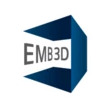What Is Emb3D?
Emb3D is a versatile 3D model viewer built for smooth visualization on mobile devices. With Emb3D, creators, students, engineers, and hobbyists can open models, orbit naturally with gestures, and inspect details without desktop overhead. Because Emb3D is optimized for smartphones and tablets, loading feels quick, navigation feels intuitive, and presentation looks polished. From quick asset spot-checks to live client walkthroughs, Emb3D turns handhelds into capable 3D windows.
Why Emb3D Stands Out on Mobile
Emb3D focuses on clarity and responsiveness. Many viewers struggle with complex meshes or slow texture handling; Emb3D emphasizes consistent frame rates and crisp rendering so models remain readable while you pan, zoom, and tumble. Emb3D blends efficient shaders, careful memory usage, and responsive UI to keep interaction snappy. The result is simple: Emb3D shortens the path from “open” to “understand.”
Gesture-First Navigation That Feels Natural
Emb3D centers its interface on touch. Pinch to zoom, drag to orbit, and two-finger gestures to pan—Emb3D makes spatial movement intuitive, even for newcomers. When a model demands precision, Emb3D supports fine control with inertial adjustments and reset framing, so you can jump back to a clean, centered view in a tap. This balance of fluid motion and precision framing is where Emb3D truly shines.
Advanced Visualization and Rendering Options
Emb3D does more than spin triangles. With Emb3D, you can switch shading styles, toggle wireframe overlays, highlight normals or edges, and adjust exposure to reveal form. Material previews and lighting presets ensure Emb3D shows surfaces the way you intended, whether you need a neutral clay look for shape review or a richer lit view for presentation. Because Emb3D is tuned for clarity, even dense meshes maintain legibility as you explore.
High-Complexity Models, Low Friction
Emb3D is designed to handle intricate designs gracefully. If your model includes heavy topology or large textures, Emb3D aims to keep interaction usable by managing resources intelligently. Emb3D helps you stay focused on geometry, proportions, and surface quality instead of fighting stutter. For reviewers and clients, that smoothness is the difference between “almost right” and “ready to approve.”
Optimized for Android and iOS
Emb3D targets modern mobile platforms with careful attention to GPU pipelines and thermal budgets. On current devices, Emb3D opens quickly, loads textures efficiently, and maintains steady performance during long sessions. Whether you’re on a compact phone or a large tablet, Emb3D adapts layouts for comfortable reach, clear buttons, and unobtrusive controls. With Emb3D, you can move from desk to field without losing insight.
A Viewer for Many Roles
Emb3D fits into diverse workflows:
- Artists: Emb3D becomes a pocket gallery for sculpt passes and retopo checks.
- Engineers: Emb3D supports fast visual validation for fit, clearance, and assembly orientation.
- Educators: Emb3D turns classroom devices into interactive exhibits where students can explore form and function.
- Clients and stakeholders: Emb3D enables quick feedback sessions anywhere—no laptop required.
In each case, Emb3D replaces guesswork with tangible, on-screen understanding.
Presentation-Ready Controls and Clean UI
Emb3D keeps the interface light so your model remains the focus. Clear icons, readable labels, and context-aware panels mean Emb3D stays out of your way. When you need information, Emb3D reveals just enough—model name, polygon hints, texture cues—without clutter. When you present, Emb3D full-screens gracefully so the audience sees design, not menus.
Precision Meets Simplicity
Emb3D balances professional control with beginner comfort. Depth cues, grid toggles, and environment lighting presets make proportion checks easier, while reset and bookmark-like framing ensure you can jump to important angles instantly. Emb3D makes precision approachable by turning complex options into simple, single-tap choices.
Lighting, Materials, and Viewing Modes
Emb3D includes lighting environments to test how forms read in different scenarios. Need a soft studio vibe or a stronger contrast to assess edges? Emb3D switches in a moment. For material sanity checks, Emb3D helps ensure albedo, roughness, and normal details remain legible. By aligning shading with intent, Emb3D turns quick previews into trustworthy reviews.
On-the-Go Asset Management
Emb3D supports browsing local storage so you can group models by project, milestone, or client. When you iterate, Emb3D makes it easy to compare versions by framing them similarly and flipping between files. That repeatable framing helps you evaluate changes fairly, and Emb3D preserves navigation fluidity so you can spot improvements fast.
Use Cases That Highlight Value
- Casting and machining checks: With Emb3D, examine draft angles, fillets, and undercuts before prototyping.
- Game asset passes: Use Emb3D to confirm silhouette, texel density perceptions, and trim blending at true handheld scale.
- Architectural massing: Emb3D helps stakeholders grasp volume, light, and context on site visits.
- Jewelry and product design: Emb3D reveals proportions and surface transitions under different lighting presets.
Across these domains, Emb3D consistently transforms review friction into informed decisions.
Performance Principles Behind the Experience
Emb3D is engineered around a few simple rules: keep frames stable, keep controls predictable, and keep visuals readable. Efficient mesh handling and smart texture management help Emb3D maintain responsiveness. Subtle UI rhythms—smooth easing, instant feedback—ensure Emb3D feels natural from the first pinch to the last pan.
Learning Curve: Minutes, Not Days
Because Emb3D maps to gestures people already know, onboarding is quick. A short overlay introduces core moves, then Emb3D gets out of the way so you can explore. If you teach others, Emb3D’s consistency makes it easy to coach: “pinch to zoom, one finger to orbit, two to pan.” Familiarity builds adoption, and adoption makes Emb3D the default mobile viewer in your toolkit.
Clarity for Reviews, Confidence for Approvals
When time is short, Emb3D helps you reach decisions faster. Crisp edges, stable shading, and quick reframing let reviewers check the right details at the right moments. Fewer delays mean fewer revisions, and Emb3D keeps everyone aligned. That alignment is where Emb3D turns visualization into progress.
Accessibility and Readability
Emb3D favors legible typography, adequate contrast, and generous touch targets. These choices make Emb3D comfortable during long sessions and inclusive for a wide range of users. Even on small screens, Emb3D prioritizes clarity so labels and controls remain understandable at a glance.
Practical Tips for Better Results
- Frame first: Use Emb3D’s reset and fit buttons to establish a neutral view before deep inspection.
- Check in multiple lights: Swap lighting presets in Emb3D to spot surface issues early.
- Use wireframe sparingly: In Emb3D, it’s great for topology checks, but disable it for form reading.
- Zoom to the problem: Let Emb3D’s precise pinch help you isolate areas without losing orientation.
- Bookmark angles (conceptually): Reproduce key views in Emb3D for consistent reviews across versions.
Small habits compound into faster approvals when you rely on Emb3D.
Mobile-Optimized Rendering Philosophy
Emb3D treats mobile GPUs as first-class. By designing around tile-based renderers and bandwidth constraints, Emb3D keeps memory usage sane and avoids unnecessary passes. That means Emb3D spends cycles where they matter most: crisp edges, readable midtones, and stable motion. Sensible priorities produce reliable perception, and Emb3D maintains that reliability across sessions.
Seamless Exploration for Iteration and Demo
Whether you’re refining a bevel or showcasing a final concept, Emb3D makes the process fluid. Start with a neutral clay, check silhouettes, switch to lit views, and finish with wireframe topology—all without breaking the flow. Emb3D keeps transitions smooth so attention stays on the design, not the tool.
Team Collaboration, Even Without a Desktop
When teams meet away from desks, Emb3D becomes a shared lens. Pass a tablet around, collect notes, and reframe instantly to answer questions. If a stakeholder wonders about edge sharpness or fillet continuity, Emb3D gives you the angle within seconds. Fast visual answers create momentum, and Emb3D keeps that momentum going.
Who Benefits Most from Emb3D
- Modelers and CAD users who need reliable mobile checks.
- Product designers presenting iterations to clients on site.
- Educators demonstrating geometry concepts interactively.
- Managers and buyers validating form and proportion before sign-off.
In each role, Emb3D compresses the time between question and clarity.
Reliability That Builds Trust
Users return to tools that behave consistently. Emb3D places a premium on deterministic controls, stable shading, and predictable loading. When you open a file, Emb3D greets you with a sensible frame; when you rotate, Emb3D respects your intent; when you zoom deep, Emb3D holds clarity as far as the asset allows. That reliability turns Emb3D from a viewer into a habit.
Technical Snapshot and Requirements
| Item | Detail | | ------------------------ | ------------------------------ | | App | Emb3D | | Latest Version | 2.0.40 | | Package Name | com.transformandlighting.emb3d | | License | Free | | Operating System | Android | | Minimum Requirement | Android 6.0 or higher | | Category | Personal | | Language | English and 46 more | | Author | Netfarm Srl | | Downloads (this release) | 1 | | Release Date | Oct 30, 2025 | | Content Rating | +3 | | Advertising | Not specified |
This overview confirms compatibility and keeps deployment simple. With current hardware, Emb3D boots quickly and gets straight to the model.
Frequently Asked Questions About Emb3D
Is Emb3D only for simple files? No. Emb3D is tuned for high-complexity meshes and large textures, prioritizing steady interaction so detailed assets remain usable.
Does Emb3D support different shading modes? Yes. Emb3D offers clay-style looks, lit views, and wireframe overlays to evaluate form, material cues, and topology.
Can beginners use Emb3D comfortably? Absolutely. Emb3D relies on familiar gestures and a clean UI, making it easy for newcomers while staying efficient for pros.
How does Emb3D handle performance over time? Emb3D manages memory and GPU workload carefully to maintain frame consistency during long sessions.
Is Emb3D good for client presentations? Yes. Emb3D’s full-screen mode, stable navigation, and quick reframing make on-site presentations straightforward.
What makes Emb3D different from desktop tools? Emb3D brings the essentials of inspection and presentation to mobile—fast, tactile, and focused—so you can review anywhere.
A Day with Emb3D in Practice
Morning: you open Emb3D to validate last night’s chamfer adjustments, swapping lighting to test highlight roll-off. Midday: a teammate sends a revised housing; you load it in Emb3D, fit to view, and confirm screw clearances with a quick orbit. Afternoon: at a client site, you launch Emb3D on a tablet, toggle wireframe to discuss rib thickness, then return to lit mode for a polished close. Evening: you compare two versions in Emb3D by reproducing the same angle and verifying silhouette improvements. In every step, Emb3D keeps focus on design, not configuration.
Why Choose Emb3D Now
Mobile review is no longer optional. Teams iterate faster, clients expect instant clarity, and field checks happen everywhere. Emb3D meets that reality with crisp visuals, reliable controls, and performance that holds up under pressure. If your workflow depends on showing and understanding 3D quickly, Emb3D is the practical, portable choice.
Conclusion: Clarity at Your Fingertips
Emb3D turns smartphones and tablets into capable 3D viewers that you can trust in real-world reviews. By pairing intuitive gestures with sharp rendering, Emb3D makes complex models approachable and presentations compelling. When approval hinges on what people see and feel, Emb3D shortens the gap between concept and conviction—one precise, responsive orbit at a time.









